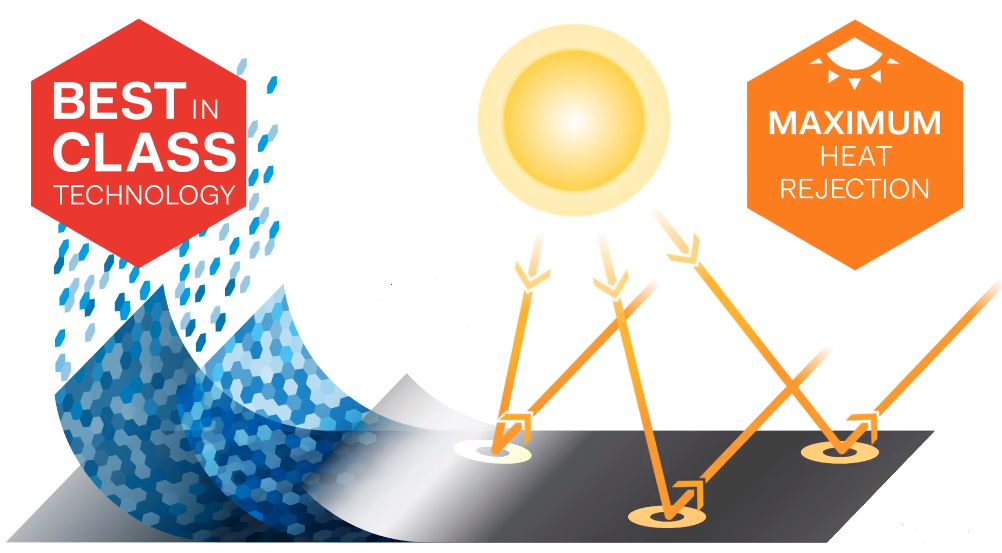
FormulaOne uses a proprietary Hybrid-Matrix. Billions of nanoscopic particles in multiple layers to create advanced infrared absorbing properties. The innovative layers are designed to trap heat and disperse it outward through your glass. The trick of the Hybrid-Matrix is:
- Size of the Ceramic Particles
- The shape of the Ceramic Particles
- The angle of the Ceramic Particles
As mentioned, this is proprietary. Eastman’s FormulaOne tint has figured it out. Laid down at just the right angle. Then another layer at another angle. And another, and another … And the majority of Infrared heat is both trapped and dispersed … never making it to the inside of the car.

≠ Not all Ceramics are created equal
So other Ceramic tints try to accomplish this with just ‘throw as much as you can on the tint till you get better heat rejection’. This causes two problems for them:
- Enough Ceramic particles and you start to infringe on the visible light spectrum (not just Infrared spectrum). More is not always better. On these tints the Ceramic tends to clump up and get way to thick. Once it gets into visible light spectrum, you can see it looking out.
Yes, you can see their Ceramic as a cloudy haze. They finally got enough Ceramic to match FormulaOne’s heat rejection but they loose optical clarity. No cloudy tint with FormulaOne Ceramics.
- Ceramic should not only absorb Infrared heat – but disperse it. IF the shape and angle of the Ceramic is correct, then it also disperses the heat back off the glass. Very important. Without this Proprietary shape and pattern, the one disadvantage of Ceramic become obvious: It fails to stop the heat after it’s absorbed all it can. Rather superior heat rejection is possible with FormulaOne tints.
- Reject massive amounts of heat without clarity loss
- Disperse heat, not just absorb heat
- Best heat rejection
- Best heat absorption
- Best clarity
- Best durability
 Imagine a sponge stopping water leaking out of a faucet. That’s great until the sponge becomes full. Then it will leak just as much as the faucet. The same with Ceramic tint that doesn’t also disperse heat back off the glass. In a momentary test, these other tints look like they do just as good, but in real world tests (asphalt parking lot in August), they FAIL.
Imagine a sponge stopping water leaking out of a faucet. That’s great until the sponge becomes full. Then it will leak just as much as the faucet. The same with Ceramic tint that doesn’t also disperse heat back off the glass. In a momentary test, these other tints look like they do just as good, but in real world tests (asphalt parking lot in August), they FAIL.
Only FormulaOne has overcome these issues with it’s proprietary Hybrid-Matrix.

Finally, one last important note about Ceramic tint. Some tint shops have stopped using Ceramic tints because, as they say: “It Oxidizes” (turns cloudy over time). That is not what is happening to the Ceramic. And nothing like that happens with FormulaOne tints.
What is happening? Ceramic used in tint is: Titanium Nitride [TiN]. Titanium Nitride oxidizes at 800 °C in a normal atmosphere. So, Oxidation is not what is happening. What is happening is a bit of a guess, since we don’t use these inferior tints. But a good guess is the glue.
They advertise they use ‘thick glue’. The biggest challenge with tint is making it optically clear when looking out. Dye or even charcoal particles (carbon) can be a minor challenge. The biggest challenge for the user is looking out two layers of polyester and a layer of glue and have optical clarity. These inferior tints brag they use twice as much glue and then say: ‘makes it stick better’. That is inaccurate. More glue is not needed… better glue is!
More glue is harder to see out. For them, not having a superior adhesion process of Eastman’s FormulaOne tints, they have to use more glue to assure it will hold up over time. Instead, over time, it becomes cloudy, it appears, because of substandard glue. NOT because of Titanium Nitride found in Ceramic tints.
FormulaOne Tint has been around for decades. Classic Sun Control even longer than that. We have done our research. We can choose any tint out there. WE choose FormulaOne. It’s warranty is the best in the business because they have the best tints in the world.
